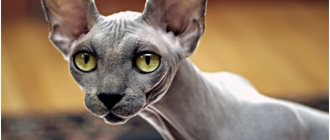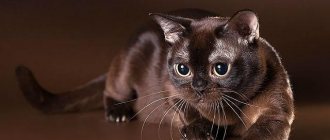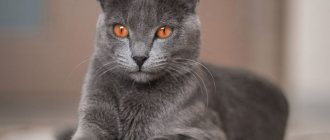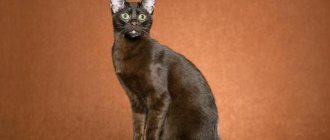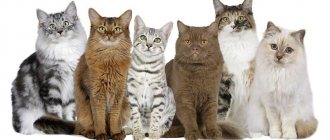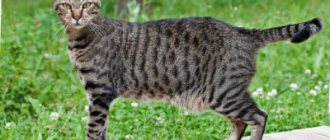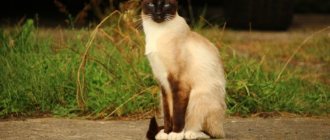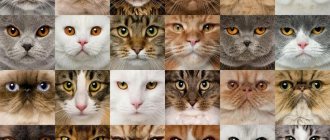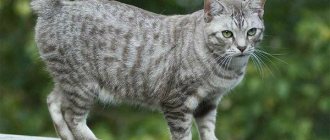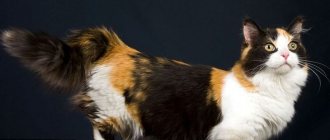Skookum - dwarf laperm
This dwarf, short-legged breed was developed by crossing Muncchins with Laperms.
The result was cats with short limbs and curly fur. Sukum can be either long-haired or short-haired. The shorter the fur, the straighter it is. Despite the genetic characteristics, this is a fairly healthy breed with no typical diseases found. By nature, dwarf lapermas are very cute and fluffy, which matches their appearance. Sukuma are playful, affectionate and sociable. These are very affectionate and loyal cats that are very curious and cheerful. Pets are very active, energetic and nimble, they can easily jump onto a bed or chair, and have a tendency to stick their curious nose everywhere. In addition, they are not afraid of water and enjoy swimming. In general, these are funny and cheerful cats. But, unfortunately, today they are very rare and can only be bought in European and American nurseries.
History of the Munchkin breed
Mentions of short-legged cats appeared in different countries. So, for example, in 1944 in Great Britain, in 1954 in the USSR (the archives mentioned the “Stalingrad Kangaroo Cat” - due to the ability to assume the position of a marmot), in 1970 in New England, and in the 1980s in USA. In 1983, Sandra Hochenedel from Louisiana adopted a pregnant stray cat, naming her Blackberry, which began the history of the Munchkin breed. The cat gave birth to kittens, among which were babies with short legs. Geneticist Dr. Solveig Pfluger, to whom Sandra turned for help, confirmed that the kittens were healthy and that the short legs were the result of a spontaneous genetic mutation. She and a kitten from her litter were used to crossbreed with domestic cats.
In 1991, breeders interested in developing a new breed tried to get the Munchkin breed recognized by TICA, but recognition was not received because little was known about the breed. A repeat attempt in 1994 was successful. But when this happened, TICA member Catherine Crawford resigned because she considered the recognition of the breed an insult, because short legs can cause numerous back problems, although there is no evidence of this. From the beginning of breeding work to the recognition of the breed, breeders were subjected to comprehensive attacks by animal rights activists and representatives of felinological organizations. Breeders were accused of conducting inhumane experiments that lead to the appearance of ugly monsters. Oddly enough, the controversy surrounding the breed contributed to its growing popularity. Munchkin cats are loved for their unusual appearance and easy and friendly disposition.
The breed appeared in Russia in 2001, where the popularity of munchkins is slowly but growing. But in Japan, these cats are literally worshiped; the breed is one of the most popular.
Cat breeds
- Photos
- Alphabetically
There are more than 101 cat breeds in the world. And each of them is characterized by its own characteristics of appearance and behavior. Each variety and subspecies has its own history of origin.
Every new cat breed that appears today is a masterpiece of creative selection. At the same time, various cat breeds that appeared in nature as a result of natural selection are also unique in their own way.
A purebred cat is not just a standard, including the size of the body, paws, and claws. First of all, he is a friend of man. And it doesn’t matter what color the cat’s fur is: black, ash or snow-white - each is good and beautiful.
Serengeti
The breed was developed by crossing several breeds:
- Bengali;
- oriental, tabby color;
- Abyssinian;
- home;
- European shorthair, wild color.
This is a new breed of expensive and rare short-haired cats. They have a large, slender and graceful body with well-developed muscles. Representatives of this breed have a predatory spotted color, in brown, silver-gray and black tones.
They have short, thick, silky fur, and their legs are very long, slender and muscular. The Serengeti's character is sociable, playful and active. Pets have a fighting disposition, but with their owner and children they are kind and sweet.
Description of the Munchkin breed
Apart from shortened limbs, munchkins are visually no different from ordinary cats, with short or long hair. The outcross program, according to which the breed is developing, provides for genetic diversity; for this purpose, as well as to obtain the necessary characteristics in the offspring, other breeds are used, in addition to ordinary domestic animals. At the same time, the task of breeders is to ensure that the result of selection does not resemble a miniature copy of a purebred pet.
Standard
The Munchkin breed standard is established by the International Cat Association (TICA). In addition to the characteristic shortened legs and slightly rounded chest, the exterior meets the following criteria:
- Head: relatively wide, a modified wedge with slightly rounded contours. The cheekbones are high, the muzzle is moderate with a firm chin, a flat forehead and a nose of medium length, which is permissible for a slight deflection.
- Ears: Triangular, relatively large, set vertically, wider at the base with rounded tips.
- Eyes: Large, walnut-shaped, set wide and at a moderate angle to the base of the ears. The cat's color does not affect their color, but it should be clean and expressive.
- Body: medium length, with pronounced muscles, strong thighs. Due to the more elongated hind limbs, there is a smooth rise of the body from the withers to the croup of the animal. The tail is of medium thickness, tapers to a rounded tip, and is carried vertically when moving.
- Limbs: short, hind legs slightly larger than forelimbs. The forelimbs are approximately 7.5 cm in length. The four paws are set straight, without curving in or out.
- The average lifespan of a Munchkin is 14-16 years, which is similar to the typical age of other cat breeds.
- The standard weight of adult cats is between 2 and 4 kg.
- The breed allows both short and long thick and soft wool, with developed undercoat, without restrictions regarding color.
Health
When the registration of the new breed was considered, some experts were against it because they believed that cats were genetically inferior and would have the same health problems as dogs with short legs, such as dachshunds. However, research shows that the Munchkin breed is characterized by good health and does not have many specific diseases.
Only occasionally are pets diagnosed with lordosis. The disease consists of a curvature of the spine that bends into the body due to shortening of the muscles that support it in the correct position. This puts pressure on the trachea, lungs and heart. Lordosis is a relatively rare disease and cats of other breeds are prone to it. In addition, Munchkins are predisposed to pectus excavatum.
Character
These unusual short-legged cats are distinguished by their cheerful disposition and friendliness, which makes them ideal companions. Munchkins are social by nature and get along well with children and pets who live in the house. They need constant communication, which means they cannot be left alone for a long time.
Cats are easy to train, so it’s easy to teach your pets tricks from early childhood. Short legs are not a deterrent for climbing curtains, bookcases or sofas. They are amazingly fast and flexible when needed.
Munchkins are observant
You can often see a cat standing on its hind legs, trying to see what has attracted its attention. They are even called “kangaroo cats” for this manner.
Types of cat breeds
All cat breeds known to the world in the cat family are conventionally divided into several groups.
- Sphynxes
This includes cats of elite breeds, devoid of hair. The first mentions of these amazing creatures date back to ancient Egypt. But directed selection began only about half a century ago. Hairless cats are absolutely devoid of aggression; they are loved for their good nature and devotion to humans. - Rex
A distinctive feature of these whiskered animals is their wavy fur. All cat breeds belonging to this group are valuable from the point of view of specialists. The first representatives of rex were discovered in the 20th century in Europe and Russia. It is believed that these pets are ideal for keeping in the home. - Short-haired
The ancestors of these cats are ordinary wild cats that lived near human dwellings and hunted mice for food. Nature has endowed them with a very beautiful and easy-to-maintain fur coat. In recent years, breeders have developed many successful short-haired breeds. - Long-haired
Pets of popular breeds with long, luxurious hair occupy a special place among purebred cats. A kitten of any long-haired breed looks like a real toy. Growing up, cats retain not only their fabulous appearance, but also their affectionate character, allowing them to get along in any family. - Wirehaired
In the middle of the 20th century, the list of cat breeds was replenished with wirehaired purrs. These animals have a perfectly proportioned body. And the phrase “coarse wool” is not due to the tactile qualities of the fur, but rather the visual ones. In addition, these truly indoor creatures evoke a lot of pleasant impressions when communicating. - Bobtails.
Muscular cats with a short tail are a real treasure of the owner. These animals embodied man's dream of taming the wild lynx. At the same time, these four-legged creatures are as loyal as dogs and know how to be gentle and affectionate.
Which breed should I choose?
Every country from China to America has its own top list of cat breeds. But most of them are cosmopolitan and loved all over the world. To make the right choice, you must first carefully read the description of purebred cats.
The opinions of experts and reviews of owners can help you navigate the huge purring kingdom. Which cat breed should you choose? The answer may seem both simple and complex - one that seems like a pearl both from an aesthetic point of view and from a psychological one. After all, communication with your pet will come first.
Self-study criteria
You can determine the breed of a cat yourself
To do this, you need to pay attention to the external distinctive features and compare them with the characteristic features of certain breeds
- I'm so typical...
If, after lengthy examinations and manipulations, it was not possible to identify the variety, the pet can be shown to a professional breeder or veterinarian. As an alternative, you can chat with cat lovers on specialized forums by showing them a photo of your pet.
You can distinguish an ordinary cat from a purebred one by the following characteristics:
Color. The color and length of the coat, the degree of coloring and pattern are some of the determining factors indicating belonging to a particular breed. Many purebred cats are characterized by the following colors: color point, smoky, blue, cream.
Body type
Attention is paid not only to the size and structure of the body, but also to the length of the legs and tail, and the location of the ears.
Head shape. Most purebred animals have an elongated and graceful head shape.
This sign indicates possible belonging to Siamese, Oriental, Bengal cats. If the pet's face is flattened, this indicates that it belongs to exotics, Pallas's cats or British cats.
Ear shape. Drop ears are found in Scottishfold animals. Curved forward - in Scottish shorthair cats. Ears turned in the opposite direction are a feature of American Curls.
Eye shape and iris color. Some breeds only have one eye color. For example, Siamese cats can only have blue eyes, while Nibelung cats can only have green eyes.
Animal paws. If the limbs seem too short compared to the body, this indicates that the dog is a Munchkin or Minskin. Thin and long paws are a feature of the Savannah, Asher and Abyssinian cats.
Tail. A tail that is too short or, conversely, long and fluffy, can indicate “blue blood.”
A fluffy tail is one of the characteristics of the breed
It is worth considering that it is impossible to determine the breed of a cat only by the color of the animal’s coat and physique, since some varieties have a similar color and body structure.
Among purebred cats, the most popular colors are:
- Blue. It is characterized by a gray-blue tint, without spots, stripes or inclusions of other colors. This coloring is typical of the Russian Blue, Scottish, British Shorthair and Nibelung cats.
- Siamese. It is characterized by a darker muzzle, ears, tail and paws. The fur coat on the body must be several tones lighter. This color is found in Thai, Himalayan, Balinese and Neva masquerade cats.
- Sandy and creamy. One of the rarest colors, which is characteristic of the Abyssinian and Somali cats.
- Chocolate. It is more common among the British and Scots.
- Tabby (striped). This color indicates belonging to a particular breed only if it is symmetrical. The most popular breeds with this coat color are the British, Siberians, Kuril Bobtails and Scots.
To increase the chance of correctly identifying the breed by color, you must also take into account the length and thickness of the coat.
Symmetrical stripes also indicate thoroughbred
On a note! The easiest way to determine the breed of a kitten is to take a photo of it and use the “search by image” function on the Internet.
Breeds that have long legs
If the Australian cat is distinguished by its particularly long paws, then there are breeds that have longer limbs compared to others. If you want your pet to have graceful, high paws, you should pay attention to the following breeds :
- Abyssinian cat - has an unusual brown color and is slender. Her legs are long and slender. With good care, this short-haired cat can live up to 20 years. Average life expectancy is 18 years. The animal has certain health problems, and therefore, when choosing such a kitten, you must take into account that veterinary expenses may be required. Some pets will have a short lifespan without treatment;
- Angora cat is a snow-white fluffy beauty with a long and bushy tail. Her paws are high and strong. This cat with long legs and tail is extremely beautiful. Despite their refined and sophisticated appearance, such cats cope well with their hunting purpose, easily catching not only mice, but even rats. The cat of this breed is quite large, and this must be taken into account when buying a kitten. The fact is that a large cat needs space;
- Bengal cat - this pet is similar in color to leopards and jaguars. A strong and muscular body and long legs make the similarity with wild relatives even greater. Despite its menacing appearance, the pet will not show aggressiveness, but it will require constant attention from humans. A special feature of the breed is its love of water and the ability to easily catch fish, which is why, if there is an aquarium in the house, it must be closed very securely so that the four-legged pet does not swim in it or go fishing.
What is special about these cats?
Brushes are not given by nature for beauty. There are several versions of their appearance:
- They amplify sound waves, so a cat can even hear the rustle of a mouse at a very long distance.
- Cat breeds with tassels are descendants of the lynx, and for them these fluffy tips served as a beacon. One could easily see a fellow in the thickets.
- According to the third version, the tassels are something like the rings of an oak tree: the older and wiser the cat, the darker the hairs.
Maine Coon
American breed from Maine. Weighs up to 15 kg - the heaviest and largest cat in the world. They are excellent hunters, and they look great; cats have gained popularity for their qualities.
It is believed that Maine Coons were created by crossing a lynx and a regular domestic cat. Evolution has done a good job on them, but the tassels on the ears remain. Friendly, sociable and affectionate cats will become excellent friends and protectors of children.
Coons have very interesting colors: fiery literally sparkles in the sun, charcoal is also not bad, but is sensitive to diet - something has changed, and the color of the coat will change.
Some are afraid that these cats are aggressive. In fact, this is completely wrong! Maine Coons rarely defend themselves with their claws, do not show aggression, and are safe.
The older a cat gets, the more time he spends resting or sleeping. Good tree climbers, they love to climb higher and watch the flow of their master's life. Make sure that shelves and beds are durable and can withstand heavy weight.
They are not afraid of water at all, they know how to swim. They don't meow, but talk. They have a muscular body, a rectangular head and a wide chest.
Kittens will quickly get used to the toilet, but you need to buy a large tray taking into account the characteristics of the pet. It is advisable to feed dry food specifically for this breed, since teeth should always be brushed.
Price per kitten: from 25,000 rubles.
Norwegian forest cat
The tassels are not as pronounced as those of Maine Coons. Cats look very bulky due to their dense fur, which traps heat. The body is strong, the fur does not allow water to pass through, which allows you to stay dry even in rainy weather.
Cats have such a claw structure that they can climb trees very well, but they cannot climb down headfirst. You can really only go down backwards. The Norwegian Forest Cat is the only breed that can climb upside down, but that's understandable! In the forests you have to climb every day; nature gave this skill to tree climbers.
The eyes are almond-shaped, the tail is very fluffy, the paws are strong, and there is a luxurious frill on the chest. Your pet will shed often, so malt paste and furminator are a must!
It is not recommended for people with allergies.
The character is peaceful, forest cats are patient even with particularly restless children, but they do not like hugs and squeezes. The best rest is on the sofa next to the owner, stretched out to his full height. They don’t take revenge; if something doesn’t suit them, they’d rather leave. It takes a lot of effort to get this charmer to let out her claws!
Price: 10,000 rubles.
Siberian cat
Classics of the genre. Warm fur coat and bushy tail, massive build. It is worth noting the teeth: they are incredibly strong. If a cat wants to bite, he will really bite and it will hurt a lot.
There are tufts between the toes, indicating a wild forest origin. Development is slow, the cat develops only by 5 years. The front legs are shorter than the hind legs, which gives them agility and grace.
The special charm of the muzzle is given by slanted eyes, long eyebrows and mustaches, often curled like a spring.
An excellent option for people prone to allergies. The fact is that the saliva of a Siberian contains a minimum of allergen.
You especially need to take care of your eyes, they often fester. The coat is brushed 3 times a week.
A little selfish. They play when they want, they will not tolerate violence against the cat’s personality. Avid lovers of heights: every shelf will be examined, even the closet will not remain untouched. And they step softly, without dropping anything.
They hunt well, catching both mice and rats. They treat strangers poorly and defend their territory. According to a typical Siberian, the best place to rest is near the battery, with the paws spread and the tail extended.
Price: from 5000 rubles.
It might be interesting: Cat breeds for allergy sufferers.
Do you want to know about other cats with ear tufts, such as caracals?
Watch the video:
https://youtube.com/watch?v=_VBgdHblChA%3F
Long-legged cats: origin and features
In fact, long-legged cats did not appear due to any mutations or evolutionary processes. The ancestors of all cats, Felis Silvestris Lybica, also had long legs. These steppe cats, which still exist today, appeared about 100,000 years ago. Of the domestic cats, the most similar to them are the Egyptian Mau, their direct descendants.
Pharaoh Akhenaten considered the cats tamed by the Egyptians to be his brothers and sisters.
In the wild, many long-legged cats have short tails, but this is not the case with their domestic relatives.
Cats began to be domesticated about 9,000 years ago - this is exactly the age of the oldest human burial in which a cat was found. Gradually spreading throughout the world, traveling with humans, cats began to change. Not only natural conditions influenced, but also mutations, and even later - targeted selection. So cats began to differ from each other, and few managed to preserve the original parameters of their ancestors.
Also, long-legged cats were obtained as a result of crossing wild cat species and their domestic breeds. For example, a striking representative of this type is the savannah - a hybrid of a serval and a domestic cat.
Features of long-legged cats:
The jump height of long-legged purrs is greater than that of more squat ones.
Long-legged cats do not require special care. Regular visits to the veterinarian, proper nutrition and an active lifestyle - and your pet will be healthy and happy.
Top 11 longest-legged cat breeds
All cats are beautiful in their own way, but long-legged cats are especially elegant and graceful. If you like just such pets, and you want to buy a long-legged beauty, then you should know which breeds can boast of such dignity.
Bengal cat - 11th place
Bengal cats are one of the most popular hybrid breeds. They are the result of crossing an Asian leopard cat and a domestic cat (several breeds). The length of their paws is slightly less than 1/2 of the height at the withers. Although Bengals' legs are quite long, this is not very noticeable due to their well-developed muscles. The most important advantage of the breed is its beautiful, clear pattern, inherited from its wild ancestor, and soft wool with a glossy shine.
The length of the Bengal cat's paws corresponds to the average parameters, but the hind legs are much longer than the front ones, which is why the impression of a tall animal is created.
Egyptian Mau - 10th place
The Egyptian Mau is a direct descendant of the Libyan steppe cat. Of course, as a result of centuries of cohabitation with humans, the legs of this breed have shortened a little, but they still remain quite long - a little more than 1/2 of the height at the withers, some individuals have even more. In addition to gracefulness and long legs, the advantages of the Mau are:
The Egyptian Mau is a beautiful breed, each cat is a unique individual with a strong character
Arabian Mau - 9th place
This is a fairly rare breed, which, like the Egyptian Mau, descends directly from the Libyan cat. Her paws are also slightly more than half the height at the withers, thin and lean. The peculiarity of these cats is that they live in the hot deserts of the Arabian Peninsula and are able to withstand 50-degree heat.
The Arabian Mau is a naturally occurring breed.
Turkish Angora - 8th place
Turkish Angoras boast not only a leg length that is more than 1/2 the height at the withers, but also a graceful build and a long neck. The spectacular parameters of Angoras cannot always be seen due to their long hair, but it only decorates these cats. In addition, Angoras are real “energizers” that will stir up even the most phlegmatic owner.
It is believed that the Prophet Muhammad had a Turkish Angora with eyes of different colors.
The Turkish Angora appears larger than its actual size due to its fluffy coat and long legs.
Abyssinian cat - 7th place
The homeland of the beautiful Abyssinian cat is Ethiopia, so many felinologists believe that she is very closely related to the Libyan cat. Indeed, Abyssinian cats clearly inherited the color type and leg length (from 1/2 to 2/3 of the height at the withers) from their wild ancestor. Their legs are quite thin, but strong, which allows Abyssinians to jump much higher than many other breeds.
Abyssinian cats are among the top 5 smartest breeds on the planet.
The Abyssinian cat is one of the most ancient breeds, and its image even adorned ancient Egyptian tombs.
Serengeti - 6th place
The Serengeti is one of the younger cat breeds. The purpose of their breeding was to create a domestic prototype of the serval and to protect wild cats from being used as exotic pets. The length of the legs of the Serengeti is slightly less than 2/3 of the height at the withers of individuals that meet the standard (there are cats with shorter legs). Another feature of the breed is its large, rounded ears, like those of a serval.
Content Rules
How to keep a cat with large ears depends solely on the breed to which it belongs. If you become the proud owner of a Turkish Angora, you will have to regularly comb out its luxurious fur with a slicker brush, and after that still clean horizontal and vertical surfaces from the consequences of its presence. If you have a Savannah or a beautiful Abyssinian galloping around your house, know that everything that is possible will be pulled out and studied from every corner of the house, so make sure that there are no beads or sharp objects in its access area.
Carefully consider the diet for your pet, consult a veterinarian. Get all the necessary vaccinations according to the schedule, and then be sure to take your cat for a preventive examination at least once every 6 months. If your cat walks outside, be sure to take timely anti-tick and anti-parasitic measures. If it is possible to purchase and put a tick collar on your animal, do so.
At home, a cat should have its own place to play, sleep and eat. Clean drinking water should always be available. Take care of a hygienic area where the cat can calmly go about his big and small business without disturbing family members.
For safety reasons, install screens on your windows, especially in the summer. Get rid of the habit of throwing windows wide open, because cats do not always measure the height from which they fall, and often suffer from this. Do not leave your pet alone for a long time; they get very bored when they are alone. And, bored, they may become offended and arrange a “surprise” for their owner when he returns.
To find out what breeds of cats with big ears there are, see the following video.
The girl saved the cat, but he turned out to be a vampire
Meet Monkey, a black cat with Dracula teeth who looks exactly like a character from a horror movie. A loving owner picked him up on one of the streets of New York and was very surprised when the baby’s fangs began to grow rapidly. Yes, Monkey has very big teeth...
Nicole Rinzi was in the car when her mother almost hit a black kitten. When the women got out of the car, they saw a starving cat covered in dirt. The eyes of animals that lead a wandering lifestyle are often affected by infection, and this baby was no exception. The kitten could barely see where he was going, so he almost got run over!
“At first I tried to find him a home, but I soon realized that our meeting was fateful,” recalls Nicole.
After she took the kitten home, his teeth began to grow, and the girl realized that this cat was special.
Monkey's fangs continued to grow and became longer and longer, and the cat began to look like a vampire. Nicole began to worry and took Monkey to the veterinarian, but after examining the cat, he came to the conclusion that the four-legged animal was completely healthy.
Munchkin
This breed of short-legged cats is not common and little known in our country. Its origins lie in 1983, when a woman in the United States picked up a stray cat with short legs. Imagine her surprise when the kittens born to her inherited their mother’s peculiarity. At the same time, the kittens were healthy and active.
It turns out that Munchkins appeared not thanks to the purposeful work of breeders, but naturally. A special mutation gene, which distinguishes the length of the legs, provided short limbs to all subsequent generations of the breed. Since this gene turned out to be dominant, when crossing Munchkins with other breeds with long legs, most kittens were born with short legs. Therefore, all other cat breeds with this feature are descended from mating with the Munchkin.
Considering the length of the limbs, munchkins are divided into three varieties:
- Dwarf;
- Standard;
- Ultra short.
It happens that kittens with standard leg length are born in a litter, but they are still carriers of the short-legged gene and their offspring will also be purebred and have short legs.
For the soul.
When you need to knock on wood, you discover that the world consists of aluminum and plastic.
When you look at cats with a lot of fingers, you realize that something is wrong here. These multi-toed cats received such unusual paws immediately at birth. This deviation is called polydactyly, a genetic abnormality that can occur in any animal, but it is especially common among cats.
Typically, a cat has five toes on its front paws and four on its back paws. Polydactyl cats, as a rule, have 1-2 more toes on one paw than their usual representatives. In addition, the configuration of these fingers can be different. The polydactyly gene manifests itself in 40-50% of cases and does not depend on the sex of the animal.
However, it has been noted that for a multi-toed kitten to be born, one of its parents must have this feature. Polydactyly is considered a fairly common anomaly among the cat brethren, which does not cause any harm to their musculoskeletal abilities, and even, on the contrary, such a number of fingers is only beneficial for cats.
The only problem noted by the owners of such cats is the more frequent need to trim the claws on additional toes. And also, the offspring of polydactyl cats have a wider and heavier bone structure, compared to the offspring obtained from the most common cats.
It is interesting that residents of New England (northeastern USA), where this phenomenon is very common among Maine Coons, consider them to be aboriginals of these lands. There is an opinion that Maine Coons are excellent hunters, and their extra toes make them more dexterous, tenacious and stable, allowing them to move freely through deep snow without falling into it.
Caring for a short-legged pet
Representatives of short-legged breeds need regular brushing and require daily bathing. Ear cleaning and eye rinsing procedures are required.
Cats do not like water, but hairless breeds should be taught to use water. Sweat and dust accumulate on the animal's body and must be removed. These cats can get sunburned or freeze in cold temperatures
It is important to monitor your pet's exposure to air.
Singapura cat
Short-legged cats do not need walking, but they will happily walk on fresh grass. Cats are not good at climbing and jumping, so it is recommended to ensure that your family pet does not fall and get injured.
Kittens should be fed 6 times a day, and adults up to 4 times a day. The diet should include protein. It is not recommended to feed raw fish. Kittens are fed special food.
Character of munchkin cats
Since childhood, kittens have shown insatiable curiosity, exploring every crevice in the house. They can do this without sleep or rest. Munchkins are friendly, sociable and cannot stand being alone.
Nature did not leave them the opportunity to hunt, so this is an exclusively domestic breed; they cannot survive on the street
It is important to take a balanced approach to the decision to become their owners.
Due to its inability to jump, it is an excellent pet, because... you don’t have to worry about vases, children’s crafts and favorite figurines standing on the top shelves. By nature, munchkins are fidgety, they love to hide things that catch their eye and do it so deftly and skillfully that it is difficult to find objects. Knowing this, it is better not to leave your car keys where your cat can reach them.
Representatives of this breed sometimes like to be alone. If you don’t buy a cat house for them, they will build one themselves from everything they find in the house.
They are not just friendly, but patient, not aggressive, not vindictive. This makes them responsible babysitters. They endure excessive affection with courage. In addition, munchkins are willing to be trained. Cats are able to sense the mood and character of their owners, even adopt them. For example, they will never wake up the family ahead of time.
They will easily make friends among both animals and people. The exceptions are rodents, birds and fish, because When meeting them, the natural hunting instinct awakens. Guests, neighbors, passers-by - munchkins will find a common language with everyone from the first minutes of their acquaintance.
They tolerate long distance travel well, quickly adapt to new places, and love walks in the fresh air. Cats of this breed can become unpretentious travel companions or simply travel quietly with their owner to visit relatives in another city.
Breed characteristics
Short legs are the result of a gene mutation that did not affect the spine and the formation of the back. The spine has retained its shape, so munchkins have the same flexibility as other cat breeds.
- The shape of the body is elongated, with well-developed muscles. Outwardly they look a little like dachshunds.
- Adults grow about 15 centimeters in height, weighing from 2 to 4 kilograms.
- The hind legs are slightly longer than the front legs.
- The neck is small, wide and muscular
- The paws come in three varieties in length and have the following names: “standard”, “short” and “rag hugger”. The last ones are the shortest of all possible ones. The paws are quite wide and with such growth they look very massive and have a rounded shape. Slight curvature of the forelimbs is allowed.
- The tail is quite thick and looks proportional to the size of the body.
- The head is small but wide and wedge-shaped. Round back of the head and not particularly pronounced wide chin.
- The ears are medium in size and have a round shape.
- The eyes are quite large, round and almond-shaped options are allowed. The eye color is usually rich; there are cases when the eyes are of different colors (for example, one eye is green and the other is blue).
- Munchkins have both long and short hair; according to the standard, the breed is considered semi-long-haired. The color can be any, all possible combinations of colors and patterns are allowed.
The munchkin cat has another interesting feature - it loves to stand on its hind legs, pressing its front legs to its body. This looks very unusual and is typical only for cats of this breed.
https://youtube.com/watch?v=52fPZRNX4zQ
Character of short-legged cats
This breed of cats is friendly and playful.
The most important thing for them is attention; the munchkin cat has a hard time withstanding loneliness. A pet of this breed will try by any means to be played with, caressed, stroked and hugged.
Munchkins get along well with children, but the child must know how to behave with the animal so that they do not harm each other. Many people note that short-legged cats are smart enough to follow commands, so you can spend some time training and teaching some commands.
Cats of this breed are very sociable and always welcome guests. They get along quite well with other pets. Moreover, it is more difficult to get along with cats than with other pets, for example, dogs.
They are absolutely not aggressive, but when it comes to self-defense, they can stand up for themselves. Quite active and mobile, they love to walk in the fresh air. They run quickly and jump well, deftly climb high furniture and curtains, so from the first days kittens should be taught order.
They respond well to training; there are usually no problems with litter box training. They are patiently able to endure a long move or transportation. They settle into a new place quite quickly.
The main differences between purebred pets and domestic ones
Scientists have proven that domestic cats have a common ancestor - the steppe cat, which still lives in North Africa . About 200 cat breeds have been registered by felinological organizations. All of them are the result of painstaking work of breeders and have clear standards. The shape of the head, muzzle, eyes, ears, length of fur, limbs, tail, body, color and character are taken into account.
Pedigree cats have documents that confirm their belonging to the breed . They record the names of its three generations and color features. The meaning of an animal's thoroughbred is that when purchasing, the owner will know exactly what character the animal has, what health nuances need to be paid attention to, and how to care for it.
For example , the Siamese cat is known for its loud meowing and vindictiveness, based on this, the future owner knows what he will have to face. Sphynx cats require special skin care and nutritional control due to their excessive appetite.
There are mixed breeds of cats with a whole bunch of genetic pathologies, but at the same time they have an attractive appearance and an easy-going disposition. All this must be taken into account when choosing a kitten - the necessary information can be obtained from the owner of the nursery. This is why experts advise contacting specialized nurseries so as not to literally buy a “pig in a poke.”
If you come across a baby not from a nursery, but, say, it was given to you as a gift, or you picked it up on the street, you can try to determine the breed yourself. To find out what breed a cat is, you need to carefully examine the animal, determine its striking features , and then study the appropriate breed standard.
You can go the simple route and contact a specialist who will tell you how to recognize a cat’s breed and point out its distinctive features. But most often on the streets there are outbred cats that only vaguely resemble their purebred relatives . Such animals often have an elongated muzzle and body, a thin build, medium-length gray, brown, black or tricolor hair, muscular paws with long claws, round eyes, and an energetic tail that expresses the entire range of emotions of the animal. Yard murkas do not exceed 50-75 cm in length and weigh between 2-6 kg.
In fact, purebred aristocrats are not much different from barn cats, so determining the breed by eye often causes difficulties. Most look closely at the external characteristics and compare them using pictures on the Internet.
However, professionals assure that appearance is not the most compelling argument in favor of an animal’s thoroughbred . The cat's habits, character, and temperament are important here. It takes a long time for outdoor cats to get used to the litter box and they don’t realize that they shouldn’t tear up the sofa or nibble on the flowers on the windowsill. Owners have to put a lot of effort into raising their pet and instilling good manners in it. Pedigree cats are another matter! They have the habits of an intellectual at the genetic level.
Features of care and maintenance
Caring for this breed does not require special skills, but you need to approach their maintenance responsibly. To maintain a healthy coat, it is enough to brush them 1-2 times a week. The exception is seasonal molting, which increases the number of procedures (individually). To do this, you can use special combs, which are selected based on the length of the coat, or special gloves for combing.
Cleanliness occupies a special place in the life of munchkins. They can be washed 2 times a week in a warm bath using veterinary shampoos. They are not afraid of water, so the procedure will bring pleasure to both the owners and the pet. After washing, dry them with a towel
It is also important to clean the ears with special lotions; veterinarians do not recommend using ear sticks, because there is a risk of damaging the eardrum
The tray should be chosen with high sides, because these clean people will diligently bury traces of their vital activity. You can purchase a closed tray with a carbon filter; it prevents the occurrence of unpleasant odors in the apartment.
The Munchkin is a breed of cat that does not require a special feeding schedule, however, these animals tend to gain excess weight, so it is important to control their diet. Specialized dry food is the best option for this breed, because
contain all the necessary nutrients and vitamins. If desired, you can include lean meat in your food. Always have clean water available. You can improve your health by taking vitamins regularly.
How to determine cat breed by size
Based on their body type, purebred cats are divided into 2 groups:
- Animals with a large, rounded head, a flattened nose and a stocky body. This is the body structure of Persians and exotics.
- Animals with a wedge-shaped head, an elongated and oblong muzzle, a long graceful body and limbs. Angora, Siamese, Balinese, longhair and oriental shorthair cats fit these characteristics.
As for the weight of purebred cats, it varies from 2 to 20 kg. The body length is 40-80 cm.
Big cats
List of giant cats:
- Ashera;
- British;
- Egyptian Mau;
- Kurilian and American bobtails;
- Maine Coon;
- Norwegian Forest Cat;
- pixie bob;
- ragamuffin;
- ragdoll;
- Siberian;
- Turkish van;
- chausie;
- chito;
- Chartreuse.
Asherah
Little cats
List of miniature breeds:
- bambino;
- Dwelf;
- Kinkaloe;
- lambkin;
- munchkin;
- minuet;
- minskin;
- Singapore;
- skookum.
Lambkin
Scottish Fold
Another cat with round ears is called the Scottish Fold. This is a very cheerful and friendly animal that does not require special care. The characteristics of the breed are:
- Medium-sized body with thick, pleasant-to-touch, plush-like fur.
- The head has a rounded muzzle and round whisker pads.
- The wide-set ears have an unusual shape - their upper part is bent so that it hides the pinna.
- Round big eyes. We allow them to have different colors, but they must match the color of their coat.
- The nose is wide.
- The tail is medium in size, tapering towards the end.
The round shape of the ears is the result of a genetic mutation in the simplest domestic cat. Animals with good care can live up to 15 years, but owners should remember two weak points of the breed. These are diseases of the joints (the tail is especially dangerous) and the heart. Cats are also prone to overeating.
Toyger
Short-haired cats, outwardly very similar to tigers in their color. The miniature tiger breed was created by crossing a domestic tabby cat and a Bengal cat.
Animals of this breed have clear vertical dark stripes throughout the body on a brown background. They have a long, wide head, deep-set eyes and small, rounded ears.
The body is long and muscular, with strong front legs and a very long striped tail. Representatives of the Toyger breed are large in size, their weight ranges from 3.5 to 7.5 kg. They have a friendly character: brindle cats get along well with their owners, children and other pets.
28.11.2017
“O little queen without a kingdom, rootless conqueror, miniature lazy tigress, you catch a wave of love in the air as you walk, barely touching the ground with your paws, sniffing suspiciously at all objects, because everything seems dirty to you in contact with your unsullied paws, oh cat. "(Adriano Bacchella. Cats)
Cat's paws deserve the closest attention and a separate story, they are so important for all aspects of a cat's life.
They are cute and fluffy, soft and graceful - you just want to pet them (which is not always what our pets like)..
But a cat's paws are also a versatile and important part of a cat's body, helping it perform a variety of actions and increasing the animal's chances of survival in the wild.
Did you know that a cat uses its paws for many purposes:
- communication with humans and other animals
- checking the environment for hazards
- hunting and defense
- caring for your hair
- body temperature regulation
- clinging to objects and deft climbing
- shock absorption during jumps or falls
- food and drink
- complacency
This story provides some interesting facts about cats' paws, their pads and claws, and how skillfully the animals use them.
1. A cat normally has five toes on its front paws and four on its back paws, unless it is multi-digitated (six or more toes)
The multi-fingered mutation in cats is called polydactyly (from the Greek poly, meaning many, and dactylos, fingers).
Multi-fingered cats are also called “Hemingway’s cats” because a large flock of six-fingered cats lived in the famous writer’s house.
Polydactyly is a genetic inheritance, not a defect. These cats perceive this as a positive trait and use the extra toe to improve stability and agility. There is a belief that polydactic cats bring good luck and happiness to the house.

